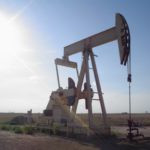 Natural gas futures rose on Wednesday as investors monitored tropical storm activity in the Atlantic and Pacific Oceans, as well as in the Gulf of Mexico. Gains were limited by forecasts for seasonal temperatures in the West and Midwest next week, curbing demand prospects for the power-station fuel.
Natural gas futures rose on Wednesday as investors monitored tropical storm activity in the Atlantic and Pacific Oceans, as well as in the Gulf of Mexico. Gains were limited by forecasts for seasonal temperatures in the West and Midwest next week, curbing demand prospects for the power-station fuel.
On the New York Mercantile Exchange, natural gas futures for delivery in November rose by 0.48% to $3.627 per million British thermal units at 13:44 GMT. Prices held in range between days high and low of $3.646 and $3.588 per mBtu. The fuel rose by 1.2% on Tuesday and extended its weekly advance to nearly 1.0% following Wednesdays gains.
Gas continued to advance after the U.S. National Hurricane Center reported that tropical storm Jerry strengthened over the central Atlantic Ocean Monday night. It has maximum sustained winds of about 40 miles per hour and is now drifting westward with a speed of 1 mph with little change in strength.
Meanwhile, the NHC also reported that a low-pressure area over the Northwestern Caribbean Sea continued to produce showers and thunderstorms and is expected to move northwestward near or over the northeastern portion of the Yucatan Peninsula later today and into the Gulf of Mexico tonight or on Thursday. It now stands a 40% chance of becoming a tropical cyclone over the next 48 hours and a 50% chance during the next five days.
This could disrupt production in the Gulf of Mexico which accounts for 5.6% of U.S. gas output according to the Energy Information Administration.
Meanwhile, another low-pressure area has formed in the Eastern Pacific, producing disorganized shower and thunderstorms. It has a 10% chance of becoming a tropical cyclone within the next 48 hours and a 20% chance over the next five days.
Tom Saal, senior vice president of energy trading at FCStone Latin America LLC in Miami, said for Bloomberg: “If a storm comes near production in the Gulf you are going to see some shut-ins because of precautionary measures. The bigger picture is that the market is now focused on the winter. It’s shrugged off some of its bearish fundamentals at the moment.”
Gains were however limited as weather forecasters predicted mostly seasonal and below-seasonal temperatures in many key U.S. consuming areas, limiting demand prospects for the fuel. Commodity Weather Group LLC in Bethesda, Maryland, reported yesterday that temperatures in the West and Midwest between October 6 and October 10 will be average or below average. AccuWeather Inc. said the low in Minneapolis on October 9 may hit 36 degrees Fahrenheit, 6 below normal. Meanwhile temperatures in Denver may bottom at 34 degrees Fahrenheit, 5 less than the average.
When warm weather is expected, natural gas surges as increased electricity demand to power air-conditioning calls for more supply of the fuel, which is used for a quarter of the U.S. electricity generation. Mild temperatures have the opposite effect. Consumption usually declines in autumn before picking from November through March. According to the Energy Information Administration, power generation accounts for 32% of U.S. gas demand and 50% of U.S. households use gas for heating.
Market players will be keeping a close watch to this week’s inventories data. Early injection estimates for this week’s build range between 82 and 100 billion cubic feet, well above last year’s 77 billion during the comparable week and the five-year average increase of 82 billion cubic feet.
Last Thursday, the Energy Information Administration reported that U.S. natural gas inventories added 87 billion cubic feet in the week ended September 20, compared to the five-year average increase of 75 billion and last year’s 79 billion build during the comparable week. Analysts expected a gain in the range between 61 billion and 71 billion cubic feet.
Natural gas held in underground storage hubs now totaled 3.386 trillion cubic feet, which is 5% below 2012′s 3.565 trillion. However, the surplus over the five-year average total value of 3 356 billion cubic feet widened to 0.9%.





